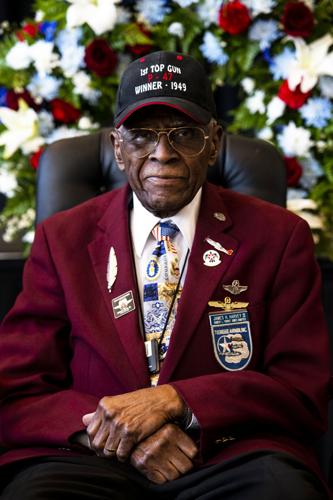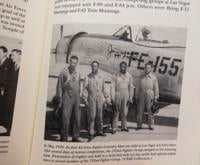Colorado’s last Tuskegee Airman is grand marshal for D.C. Memorial Day parade
One of the last living Tuskegee Airmen, Colorado’s Lt. Col. James Harvey, will serve as grand marshal at this year’s Memorial Day Parade in Washington D.C. Last month, Harvey, 98, received a warm reception and much appreciation from current and former Air Force Academy cadets in Colorado Springs. (Video: Stephanie Earls/The Gazette)
{
“@context”: “https://schema.org”,
“@type”: “VideoObject”,
“name”: “Air Force cadets show their appreciation to Lt. Col. James Harvey”,
“description”: “One of the last living Tuskegee Airmen, Colorado’s Lt. Col. James Harvey, will serve as grand marshal at this year’s Memorial Day Parade in Washington D.C. Last month, Harvey, 98, received a warm reception and much appreciation from current and former Air Force Academy cadets in Colorado Springs. (Video: Stephanie Earls/The Gazette)”,
“thumbnailUrl”: “https://bloximages.newyork1.vip.townnews.com/denvergazette.com/content/tncms/assets/v3/editorial/d/bd/dbd8d5da-3bdf-547f-840c-11d4e4f71f38/6293016878c55.image.png?resize=1396%2C785”,
“uploadDate”: “2022-05-29T00:00:00-06:00”,
“contentUrl”: “https://cdn.field59.com/GAZETTE/31dfeb46386f42393389d83521a8feb498d96700_fl9-360p.mp4”
}
Lt. Col. James Harvey III — one of the last surviving Tuskegee Airmen — grew up in the Northeast’s industrial heartland in the 1920s and ’30s, living the “good life” in what felt like a colorblind world.
He was senior class president and valedictorian at his school in rural Pennsylvania; basketball captain and anchor on the gymnastics team, which meant he got to “hold all the pretty girls.”
If somebody wanted his attention, they addressed him by his name.

Colorado resident Lt. Col. James H. Harvey III, one of the last original documented Tuskegee Airmen, will serve as the grand marshal of the 2022 National Memorial Day Parade in Washington.
“We were the only family, and I was the only person of color in the school, but there was no name-calling, nothing like that. I was one of them,” said Harvey, now 98 and a longtime resident of the Denver area.
That early idyll of equality shattered after he was drafted into the Army in 1943 and boarded a train to Fort Meade in Maryland.
“I got to Washington, D.C., the next morning, real early, got out of the car I was in and went and got breakfast,” Harvey recalled.

Only a handful of the fewer than 1,000 original documented Tuskegee Airmen are still alive.
When he went to reboard the train, he was told he had to find a new seat.
“They said, ‘You ride in the car where Negroes ride. Welcome to the South,’” Harvey said. “This was Washington, D.C. The Mason-Dixon Line runs right through there.”
Almost 80 years later, Harvey is back in the nation’s capital for a ride of honor, down Constitution Avenue, as the grand marshal for the 2022 National Memorial Day Parade, which kicks off noon MDT Monday and will be nationally televised.
“I feel fine about it. I feel good. I’m taking my two daughters, who are going to be in the parade with me,” Harvey said. “I’m not a hero … just an ordinary person ….”
Who did extraordinary things, despite extraordinary obstacles.

One of the last living Tuskegee Airmen, Colorado’s Lt. Col. James Harvey’s signature in an Air Force Academy cadet’s book.
Of the fewer than 1,000 documented original Tuskegee Airmen, only a handful are still alive. When Colorado Springs resident Frank Macon died in November 2020, Harvey became the state’s last Tuskegee hero.

Lt. Col. James Harvey, 98, one of the last living Tuskegee Airmen, waves to a crowd of people after being introduced as a guest of honor during the Air Force Academy’s wreath laying ceremony that honors Tuskegee Airmen on April 29.

Lt. Col. James Harvey, 98, signs an Air Force Academy cadet’s book following a wreath laying ceremony to honor Tuskegee Airmen on April 29.
“We were the best of the best,” Harvey said. “We had to be. We had to keep proving ourselves throughout our careers, because of our color.”
America’s first Black military pilots and crewmen are now legendary, their stories the subject of books and blockbusters. Tuskegee pilots with the 332nd Fighter Group flew more than 400 missions, primarily as bomber escorts, and never lost a plane to enemy action. They proved that Black pilots not only could meet, but exceed the skills of their White counterparts.
“The white fighter groups … the fighters would take off after the Germans that were coming in to shoot the bombers down. They wanted to be aces. Five kills and you’re an ace,” Harvey said. But “when they did that, there was another group of Germans waiting (to) peel off and come in to shoot the bombers.”
White pilots, he said, were losing an average of 43 bombers per mission. Each bomber carried between 10 and 12 men.
“That’s a lot of people,” Harvey said. “The losses were too high.”
Two Colorado veterans featured in Tuskegee Airmen documentary
When the 332nd Fighter Group got the mission to escort bombers, then-Col. Benjamin O. Davis Jr. — commander of the WWII Tuskegee Airmen and later the first African American brigadier general in the U.S. Air Force — told his pilots their mission was to escort, period.
“He said, ‘You will stay with the bombers. If you don’t, you will be court-martialed and you’ll never fly again.’ So that’s what we did,” Harvey said.
The Tuskegee pilots, whose planes bore distinctive red paint on their tails, earned the nickname “Red Tail Angels” among the military whose lives they had saved or who knew of their deeds.
Making sure those deeds made it into the historical record, however, would take much more than saving lives or being the best.
“Now that’s another story,” Harvey said.
One of many.
Colorado Springs community mourns beloved father figure, Tuskegee Airman, James Randall
But let’s back up a minute, to the brief scene that set up everything to come.
Harvey was a kid, standing in his yard in Nuangola, Pa., when he heard a loud noise and looked up.
“There were four P-40s flying in formation. I said, ‘I’d like to do that one day,’” he said. “That was it.”
He tried to join the Army Air Corps after high school, but was told they weren’t accepting enlistments. It was the height of the war; Harvey knew it was a lie.

Lt. Col. James Harvey, 98, one of the last living Tuskegee Airmen, receives appreciation from current and former Air Force Academy cadets following a wreath laying ceremony at the Air Force Academy on April 29.
“It was because of my color,” he said. “Gen. ‘Hap’ Arnold did not want any Blacks in his white Army Air Corps. He said so.”
“I say, ‘their loss.’”
Harvey would find his way into the air, with some of the best pilots in the military, soon enough. Initially after being drafted, though, he was assigned to the Army Air Corps engineers, driving bulldozers, graders and the heavy machinery that could turn a jungle into an airfield.
Digging earth wasn’t a good fit for a young man with his eyes on the sky. He applied to be a cadet and took the Cadet Training Exam at Bolling Field in D.C.
“There were 10 of us, nine white guys and myself,” Harvey said. “Two of us passed. Myself and one of the white guys.”
From there, Harvey headed to basic training in Biloxi, Miss., before transferring to Tuskegee Army Air Field in Alabama to begin pilot training.
He didn’t know what to expect before he arrived in Alabama. He certainly didn’t expect to see a bunch of men who looked like him.
But he was there to do a job.
“Ok, let’s fly. But first, I had to learn how to be a pilot,” he said.
Primary training was given by Tuskegee graduates whose job was not only to teach the men how to fly, but how to handle what they would face in the military once they left the Alabama base.
“They prepared us for these white instructors that we would get in basic and advanced that would be calling us all kinds of names and things to provoke us to do something so they could wash us out,” Harvey said.
The washout or failure rate for white cadets in the early 40s was running at 63%, he said.
It was 40% for the first class that went through Tuskegee.
“They said no, no, no, no this will never happen again, so they made sure they had a washout rate for us of 73% or higher,” Harvey said. “The class ahead of me on graduation day, one of the cadets had a spot on his trousers. They washed him out. Didn’t have anything to do with his flying. They had to get to that 73% figure.”
Everything the Tuskegee Airmen did had to be perfect.
“Which is good. That made us what we were,” he said.
Harvey received his wings and commission as a second lieutenant flying officer, and in April 1945 finished his combat training at Walterboro Army Air Field in South Carolina. He was heading off to war.
“I had my bags packed, within one hour of catching a train to go to Norfolk, Va., to get on a ship to go over and join the group, when we got a message. The war in Italy was over, and they were expecting to wind up the whole European Theater,” Harvey said.
Hitler’s surrender was nigh, and came the following month.
“The reason he gave up? He heard I was on my way,” Harvey said, and laughed.
He would get his chance to demonstrate his flying skills in combat about five years later, becoming the first Black Air Force jet pilot to fight in the Korean War. He went on to fly 140 missions and earn the Distinguished Flying Cross, among other medals.
He retired from the military in 1965, and seven years later moved his family to Colorado for a job with Oscar Meyer, going on to become the company’s first Black center manager.
Through it all, he never gave up the fight, or the hope that he and the men he served with would finally get the recognition they’d long been denied — especially regarding the first-ever military “Top Gun” style weapons competition.
In January 1949, the chief of staff of the newly formed U.S. Air Force sent a directive out to all the nation’s fighter groups, announcing a weapons training competition, at Nellis Air Force Base in Nevada.
Harvey was among a three-man team of Tuskegee pilots chosen to represent the group in a series of trials including aerial gunnery, dive and skip bombing, rocket firing and panel strafing.
After multiple days of contests, the Tuskegee pilots had the highest score and took the team award.
A ceremony was held at the Flamingo Hotel, the only hotel on the Las Vegas Strip, which was segregated.
“The only reason they accepted us when we won the meet is we were part of this big group and the Air Force had blocked off this space in the hotel for this particular event,” Harvey said. “The people weren’t happy about it at all, because they didn’t expect to see us there. We came with the package.”
When the announcement was made that the Tuskegee Airmen had won, there was no applause. The room was quiet.
“It was very intense, because we weren’t supposed to win,” Harvey said.

Lt. Col. James H. Harvey was part of a four-man team of Tuskegee pilots who won the team competition at the first ever “Top Gun”-style weapons competition, in 1949. The 3-foot, silver trophy then went missing for 55 years. The fight to get the Tuskegee team officially recognized and listed as the 1949 winners only came to an end in early 2022.
They were allowed to pose for a photo with their trophy, a 3-foot-tall silver creation with cup on top and engraved plaque at its base.
Little did Harvey know that would be the last time he would see the award for more than 50 years, until a deathbed request by another Tuskegee Airman sent historian Zellie Orr on a quest to find it.
It took her about a week to find the trophy in storage at Wright-Patterson Air Force Base in Ohio.
“They found it, then they all re-sent in their paperwork to get recognized. … So since then (the mid-1990s) that trophy has been on display at Wright-Pat permanently,” said Elizabeth Harper, historian for the Denver-based Hubert L. “Hooks” Jones Chapter of Tuskegee Airmen Inc., and co-author of Frank Macon’s book “I Wanted to be a Pilot: The Making of a Tuskegee Airman.”
Seeing the trophy installed in its rightful place of honor felt good, Harvey said. But there was still more work to be done.
Since the first Top Gun competition, the names of winners have been recorded in an almanac published by the Air Force, as well as a plaque at Nellis Air Force Base.
The team winner for 1949 has always read: “unknown, unknown, unknown,” Harvey said.
Until earlier this year, after Harper helped connect Harvey with the Denver-based Wish of a Lifetime Foundation, an AARP program aimed at fulfilling lifelong dreams for older adults, and sharing their stories.
“This wish of Harvey’s was to be officially recognized, because they weren’t. His wish was to have their (fighter group) names posted on that plaque, saying that they had won the first one,” Harper said. “They granted his wish.”
That long-overdue correction of the record happened Jan. 22, at a ceremony at Nellis which Harvey attended, unveiling the new plaque.
“I’ve been fighting and telling the story … 73 years, that’s a lifetime for some people,” he said. “I can finally close the chapter on it. Now I’m going to get another project.”
After Memorial Day, of course, and after he returns from a trip aboard the Queen Elizabeth II to England, where he has an upcoming interview with the BBC.
“Retirement has been good; my whole life has been good,” he said. Even when he wasn’t necessarily living the “good life” of his youth.
“I don’t get mad or I’d stay mad,” he said, “and I don’t want that.”















